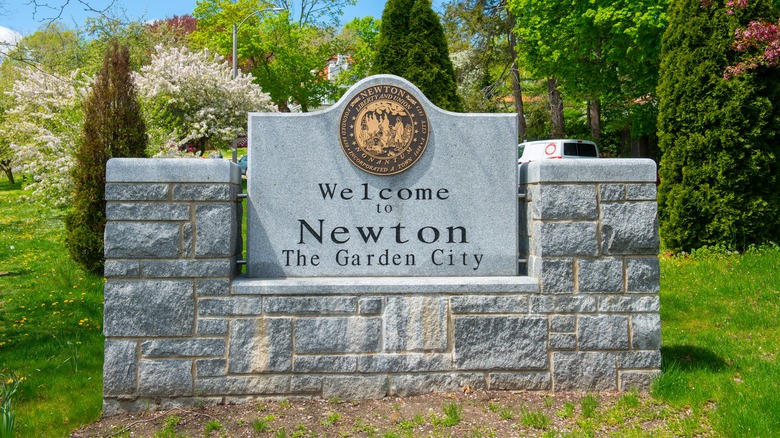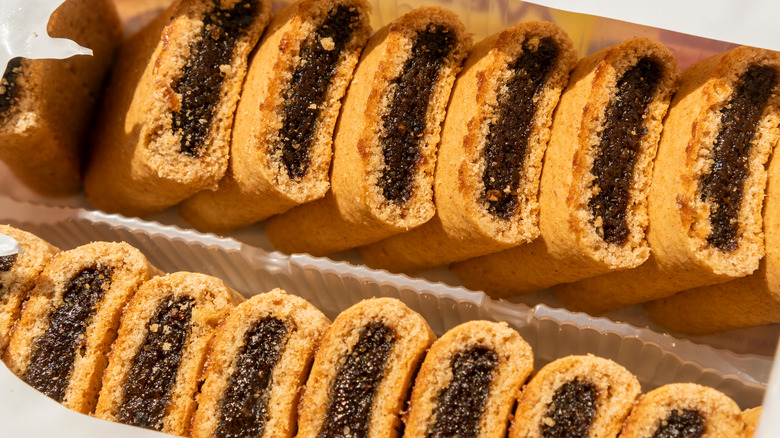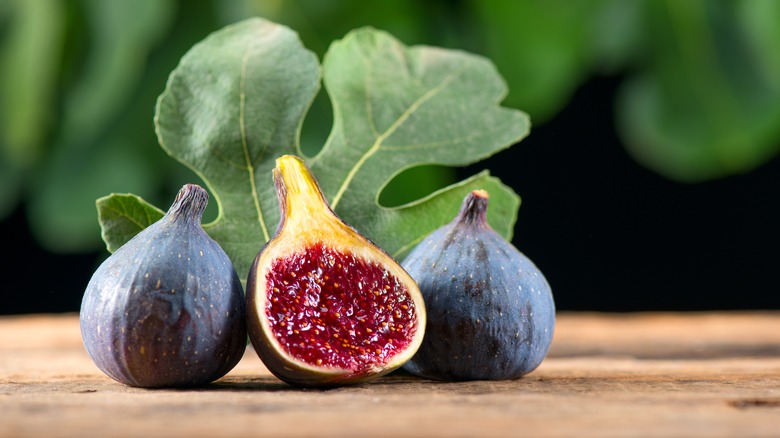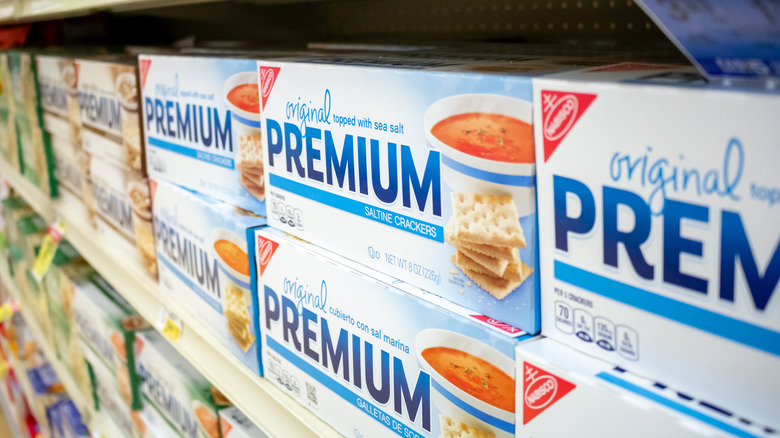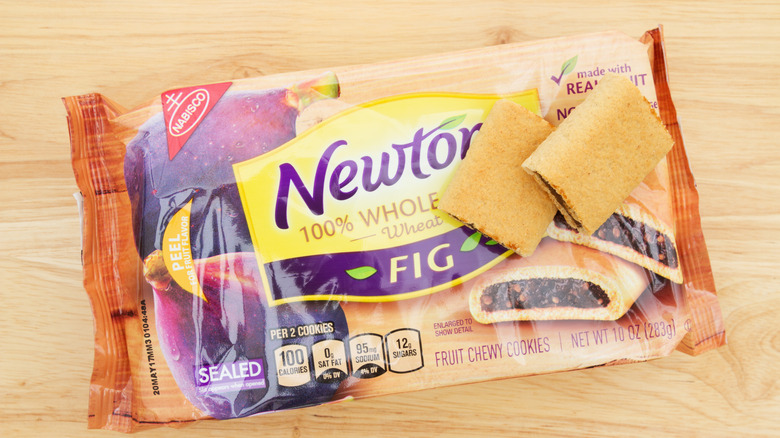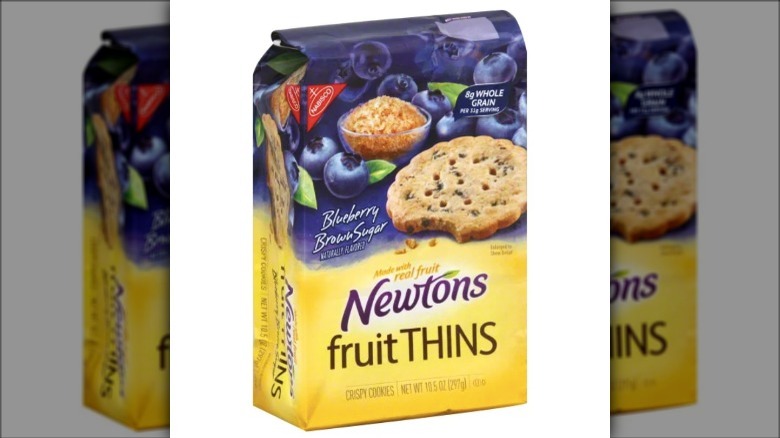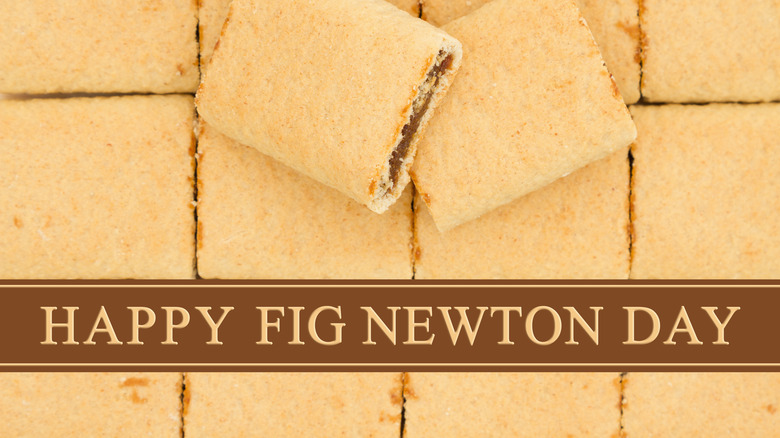The Ultimate History Guide To Fig Newtons
Fig Newtons, or Newtons as we know them today, are a soft yet chewy and sweet fruity treat that can be found in many snack cabinets around America. The cookie is a favorite addition to lunch or snack time, and they pair perfectly with a cup of hot tea or coffee. Fig Newtons are a classic that remains one of the top cookies in the United States. However, they've undergone a lot of changes since their conception in 1891. Although the basic recipe and concept of the cookie are the same, everything from the name, the flavors, and the description of the snack has been altered to some degree.
These cookies are a true testament to teamwork. The soft, delicate dough works perfectly alongside the sweet sticky center, but the blending doesn't end there. From its creation, this sweet treat was a combination of ideas from a cookie maker working with an inventor. Even the baking company, over time, would merge with another brand to form a whole new one.
All of these contributing factors have impacted the journey of Fig Newtons and brought them to their place among the favorites, such as Oreos and Chips Ahoy! In fact, according to South Florida Reporter, Fig Newtons are the third most popular cookie in the U.S. today. A billion Fig Newtons are enjoyed every year, and they don't seem to be going anywhere soon. The next time you dish out a tray of these for your friends and family, you can appreciate them even more with this ultimate guide to the history of Fig Newtons.
The cookie maker: Charles M. Roser
This history guide to a classic cookie begins with the master behind the recipe, and that's the cookie maker, Charles M. Roser. The famed sticky filling that is dark purple in color with a sweet flavor can be credited to this creative baker who was originally born in Ohio. It's believed that the recipe's original inspiration came from another treat known as the fig roll, which British immigrants introduced. This dessert had a pastry-like exterior and was filled with jam. The idea for the sweet, fruity filling was bound for greatness.
Later in Philadelphia, Roser was working in a bakery, and they sold the recipe for Fig Newtons filling to the Kennedy Biscuit Company, which was based in Boston. This company has been in business since 1869, and although it functions under a new name, the brand continues to churn out classic favorites, such as Fig Newtons. Although the exact recipe is a secret, of course, many copycat recipes for Fig Newtons have gotten close to perfection.
In recognition of the creator of such a famed cookie, Roser Park, a neighborhood in St. Petersburg, was named after the baker and listed on the National Register of Historic Places. This federal listing can be traced back to the early 1900s when Roser actually began buying and building many homes in the area. Cookie lovers can visit the namesake of Fig Newtons in Newton, Massachusetts, but true fans will take a trip to Roser Park to fully appreciate the original cookie maker.
The origins of the Fig Newton name
Even though the name has been slightly changed over the years, it's undeniably recognized by many people of all ages. However, there has been some confusion by enthusiasts about where the name for these favorite cookies actually came from. Part of this is due to the exceptional technology that made the production of these cookies possible. Some thought that the machinery was so complex that the cookies deserved a name that was synonymous with genius, and the name is often tied to the scientist Sir Isaac Newton.
However, this theory has been debunked. The name Fig Newtons actually comes from the original buyer of the recipe, the Kennedy Biscuit Company, which was later also responsible for the creation of Oreos. The brand, feeling loyal or especially appreciative of its New England roots, named the cookie after the Massachusetts town named Newton. The fig part of the name refers to the fruit used to make the filling. However, the fig is not always included in the title and was later officially dropped.
The beginning company was actually well-known for this practice of naming cookies after Massachusetts towns. In fact, several others already donned New England names. For example, Beacon Hill cookies are a type of chocolate meringue cookie named after the neighborhood in Boston. Another cookie with a Massachusetts name was Shrewsbury, a short-bread-like cookie that was often made with a jam filling by the company.
Getting the cookies on the shelves
In the late 1800s and early 1900s, it wasn't such an easy thing to mass-produce a two-part cookie that had a doughy exterior and a stick, jam-like filling. Once the recipe for Fig Newtons center was created, the next question was how to make them and produce them in large amounts. The answer came from an inventor in Florida named James Henry Mitchell, who happened to be working at the Kennedy Biscuit Company around the same time. Without the creation of his new machine, filled cookies of all kinds would not be where they are today.
The advanced machine worked in tandem to funnel the cookie dough while funneling the fruit preserves into the center. This method produced one long, flat cake that was prefilled with delectable fig preserves. Mitchell's machine was a game-changer for the cookie industry. However, in the beginning, it wasn't capable of slicing the cookies. The giant cookie log still had to be cut by hand before being packaged. Still, the machine eliminated the method of using a filling bag to pipe fruity preserves into the cookies, which was time-consuming and messy.
This machine greatly contributed to the shape of the cookies and is an easy way for people to make homemade Fig Newtons without fancy equipment. Most recipes today encourage bakers to make one long cookie, which is easier to fill. This method also contributed to the idea of longer Fig Newton bars, which eventually became another product available from the manufacturers.
All about the figs
Prior to the famed Fig Newtons, the fig fruit, which comes from the Ficus plant, did not gain a lot of recognition. Not too many figs were actually being consumed in general, and they certainly weren't excelling in the dessert or cookie industry. However, the fruit quickly became recognized because of the cookies, for their natural sweetness and possible health benefits. Soon enough, the fruit was popping up on menus all over and continues to grow in popularity in recipes such as figgy pudding and fig brandy.
Figs are naturally sweet, which is why they were often used as a replacement for sugar when supplies ran low. In addition, the slightly crunchy seeds in the figs gave the filling a bit of texture, and this combination became the perfect center for the cookies. On top of tasting great, it's been said that figs are loaded with healthy nutrients and vitamins that make them a smart alternative to other sweeteners.
These tear-drop-shaped purple fruits, with their reddish-pink insides, are an excellent source of fiber, which means they can go a long way to promote healthy digestion if consumed correctly, according to Healthline.
In addition, figs contain amounts of potassium, calcium, magnesium, and iron, which are not always a big part of the average diet. Digestive health in a yummy snack was the main attraction when Fig Newtons first hit the market. Today, there's also evidence to suggest that figs can improve your skin and heart health. Figs may also help level out blood sugar levels and other benefits.
A merging of companies
Part of the success of the cookies can be traced back to the original company that transformed the recipe with special machinery and made mass production possible. However, the real magic began when a powerhouse known as the National Biscuit Company took charge. The Fig Newtons ownership passed hands several times before they became the third most popular cookie in the United States, but each new transaction played a pivotal role in the history of this classic treat.
In 1898, just a handful of years after the cookie's creation, the company was bought out, and a conglomeration of cookie and cake makers were brought together to form The National Biscuit Company or N.B.C. This merger brought together a total of 114 bakeries, but the power players were the midwestern American Biscuit Company and the eastern New York Biscuit Company.
These two brands had already accumulated a large number of bakeries prior, which meant that the newly formed N.B.C. was at the top of the food chain in the biscuit world. At the time, biscuits represented much more and included many types of cookies, crackers, and cakes.
The merger also brought about higher standards and exact practices that took the name brand products to another level. Soon enough, the logo was instantly recognizable, the customers were loyal, and the company elevated the advertising game, spending a record amount of money on promoting their cookies and crackers. The company progressed even further and merged with Standard Brands in 1981 to form Nabisco Brands, later known as Nabisco Food Groups. They are most famously known for creating Premium Saltines and Fig Newtons.
Cakes to chewy cookies and other changes
As times changed, so did these beloved cookies. As a way to attract more buyers and appeal to a wider group of people, Fig Newtons underwent a variety of alterations that eventually pushed them to the near top of the favorite list. Some changes were so small even fans of the cookies might've missed them.
For example, Fig Newtons were for sale for over 100 years before they were known as cookies. The original packaging described these snacks as cakes instead. From there, they were labeled as chewy cookies, playing up the fruity preserves inside and calling attention to the health benefits of the figs.
Also, Fig Newtons may have started as a log that was cut into cookies in one flavor, but there are now a ton of variations to purchase, from fat-free and whole-grain options to different fruits and various sizes to choose from. However, the consumers remained loyal over the years. Even though Fig Newtons became the third most popular cookie in the United States, New Englanders continue to be the top consumers.
The biggest change occurred around 2012 when the manufacturers no longer saw the appeal of using the word fig in the title. The fruit was often associated with helping digestion and was believed to attract an older audience, and fig was officially dropped from the name. In addition, the new name, Newtons, opened the door for other fruits and flavors to be displayed on the box without causing any confusion.
Sales throughout the years
These fig cookies have an impressive track record when it comes to sales over the years. And now, over a hundred years since their creation, about one billion are still enjoyed every year. The popularity does not seem to be going anywhere, but there were ups and downs.
That is ultimately why a few rebranding techniques were necessary along the way. In the late 2000s, the interest in these fruity cookies began to wane. They were popular among older generations who grew up with a steady supply Yet, at some point, they stopped appealing to younger crowds.
It was difficult for a square cookie that was made with real fruit and boasted an excellent source of fiber to compete with other more modern brands and products. For four years, the numbers began to slope down, and the marketers decided it was high time to conduct some research to unearth the problem. It was around this time that the word fig was dropped, and the interest of the younger generations was piqued.
In addition, the brand launched Newtons Fruit Thins, which were a crunchy treat that quickly gained attention and revived the appreciation for the classic brand. These new cookies were a cross between a cookie and a cracker. They were a more traditional round shape and came in a variety of flavors. As more were sold, more flavors and fruits were introduced, such as blueberry, lemon crisp, and banana drizzled with dark fudge. In just a year, the numbers for traditional Newtons increased, and the new Fruit Thins pulled in $47.7 million in revenue.
National Fig Newton Day
Mark your calendars because January 16th is National Fig Newton Day. This day is dedicated to the favorite cookie and has inspired many celebrations of all sizes across the country, especially in Newton, Massachusetts. In 1991, the festivities were enjoyed by thousands who celebrated in the Boston suburb with free cookies and more entertainment on the 100-year anniversary of the cookie's creation.
Staying true to the cookie theme, the singer Juice Newton performed at the event, and a 100-foot Fig Newton cookie was served. Mr. Big Fig, a beloved TV character from a Fig Newtons commercial, appeared, and thousands of cookies were handed out to those with a sweet tooth outside of City Hall. At the celebration, students even portrayed fig-inspired paintings that showcased the cookies throughout several famous paintings and situations.
This celebration was another way to attract buyers and boost sales; however, it's an undeniably festive addition to a slow January calendar. These days, when January 16 rolls around, you may spot free cookie samples in supermarkets and special displays of classic Fig Newtons and even off-brands in stores. School students might also expect an extra sweet treat on this day, which can be enjoyed with a cup of tea or milk.
Despite the focus on real fruit and natural source of fiber, the cookies, overall, are a dessert and continue to inspire smiles around the country. Today, bakers and home chefs alike take inspiration from the cookies, using them as pie crusts or as an addition to ice cream and whipped topping, marking the continual appreciation, not just on National Fig Newton Day.
When other flavors were added
Since the word fig was dropped from the title, Newtons took the opportunity to expand their brand with new flavors. Around the year 2012, the brand experimented with Sweet Peach & Apricot Newtons. They also boasted the made-with-real-fruit and a good source of fiber angle in order to attract buyers. However, that and many of the other experimental flavors were discontinued a few short years later. Other more adventurous flavors hit the market as well.
Although they were exciting, few remained available for long. Some flavors included Fig Newtons Bars Raspberry & Yogurt, Strawberry Kiwi Fruit, Strawberry Shortcake Cookies, and more. These have all been discontinued.
Today, only a few select flavors can still be bought. Newtons Whole Grain Triple Berry cookies are still made with a combination of blueberry, raspberry, and strawberry puree. In addition, simple Strawberry Newtons have also become a popular favorite. These are made with strawberry puree and apple powder for a fresh fruity flavor.
Fig Newtons were almost Massachusetts' state cookie
Knowing that Newtons got the name from a Massachusetts town makes it unsurprising that the famed cookies were almost named the official state cookie after where they were first made as well. However, it may surprise you that the Toll House Chocolate Chip cookie actually beat out the classic when the time came to vote.
At the time, in 1997, the Massachusetts Governor, William F. Weld, wanted to throw another option into the mix for the state cookie. He claimed that Fig Newtons were a perfect option because they were so popular when he was growing up. After all, the cookies could be found in most pantries, and they were named after a Boston suburb.
The suggestions seemed like a no-brainer. In fact, many already believed Newtons were the state cookie. However, the chocolate chip cookie won out, as the inventor also called Massachusetts home, and they were created at the Toll House restaurant in Whitman.


